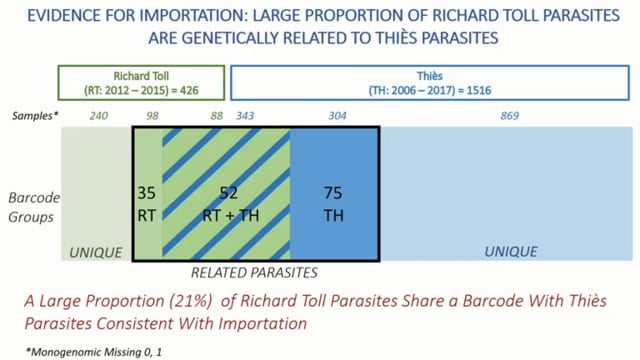ASTMH 2018, Sarah Volkman: “Application Of Parasite Genetic Relatedness To Identify Transmission Patterns For Malaria Elimination Efforts In Richard Toll, Senegal”
Collaborator(s): Harvard T.H. Chan School of Public Health (HSPH), United States
Countries: Senegal
Published: 31/10/2018
In collaboration with ASTMH, Image Audiovisuals, and session presenters, MESA brings you this webcast from the 67th ASTMH annual meeting in New Orleans, October 2018
Title: “Application Of Parasite Genetic Relatedness To Identify Transmission Patterns For Malaria Elimination Efforts In Richard Toll, Senegal”
Speaker: Sarah Volkman, Harvard T.H. Chan School of Public Health, Boston, MA, United States
Session information:
Symposium 118: Malaria Elimination in Asia and Africa
October 31, 2018, 8:00 AM – 9:45 AM, Marriott – Mardi Gras D (3rd Floor)
Abstract:
Senegal has three distinct malaria transmission zones ranging from relatively high incidence rates in the South (> 250/1000) to very low incidence rates (< 2/1000) in the North. The majority (~85%) of clinical malaria cases in the northern Senegal district of Richard Toll are found among individuals with a travel history and are therefore classified as representing imported infections1. We compared genetic relatedness between parasite infections and travel history to test the hypothesis that local infections occur in Richard Toll. Previous studies using genetic relatedness reveal increased proportions of highly related parasites in low transmission settings, with evidence of clonal parasites that persist across multiple transmission seasons2. We successfully genotyped 646 RDT-positive samples collected in Richard Toll district between 2012 and 2015 using a molecular barcode tool that assesses 24-single nucleotide polymorphisms. The majority (471/646 = 73%) of these represented monogenomic infections (expected with low transmission intensity), with increased polygenomic infections among those with travel history (p = 0.03). Consistent with local transmission, we detected eight persistent clonal lineages in multiple years from 2012 and 2015, mainly among individuals with no travel history. We also observed clusters of genetically identical infections within households with no travel history (p = 0.03). Despite limited data from across Senegal, we were able to identify (6%) parasites that were identical or closely related to parasites being actively transmitted in Dakar, Thies, Kaolack, and Touba. These results demonstrate connectivity with other parts of Senegal and receptivity for transmission within Richard Toll. These findings reveal indigenous transmission is likely in this very low prevalence region, and underscores the utility of genomic data to resolve malaria transmission patterns to stratify interventions for successful malaria elimination.
1. Littrell, PMID: 24044506, 2. Daniels, PMID: 25941365


